You planned this getaway weekend to Wise County, Virginia months ago. A cabin is ready. A rental car awaits you when you land at Lonesome Pine airport (KLNP). It’s good to be instrument rated. The reported ceilings are comfortably high at 1500 AGL. It’s nice to have the protection of an instrument approach when going somewhere new, especially in the Appalachians.
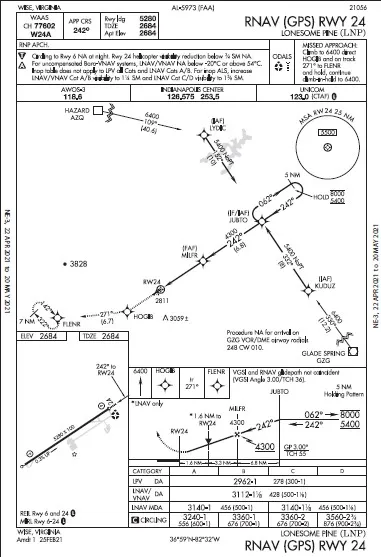
One problem. You got a late start and its getting dark. Checking the FIS-B weather, the winds are from the north, favoring Runway 6. But the RNAV (GPS) approach to Runway 6 is “NA at Night.” Runway 24 has both a LOC and a GPS approach but circling to Runway 6 is also “NA at Night.”
What is “Night”?
We tend to talk about the Federal Aviation Regulations at Title 14 of the Code of Federal Regulations having three definitions of “night.” But two of the three deal with special situations.
For carrying passengers at “night,” §61.57(b) requires three takeoffs and landings to a full stop “during the period beginning 1 hour after sunset and ending 1 hour before sunrise.” Another regulation, §91.209(a), requires us to turn on our position lights “from sunset to sunrise.” But with those two exceptions, when the FAA says “night” they’re referencing the definition in §1.1, “Night means the time between the end of evening civil twilight and the beginning of morning civil twilight, as published in the Air Almanac, converted to local time”. That’s the one to use when an approach is “NA at Night.”
Why “NA at Night”?
It’s all about obstacles and the ability to see them. All approaches have a visual segment. It might be a published visual flight path like those we talked about in “Dead Reckoning in IFR” in the March 2021 IFR but, more commonly, it’s just the portion of the approach below the MDA or DA. The published altitude minimums tell us how low we can go. The published visibility tells us how far we must be able to see when we get there. And §91.175(c)(3) tells us what we must be able to see in order to continue beyond the MAP and land. But seeing the runway environment is not the only important thing about visibility. There may be obstacles between the approach altitude minimums and the surface of the runway. It’s good to be able to see them.
Without delving too deeply into TERPS, the guidelines for designing approaches ask two questions about obstacles. “Are there any?” If so, they ask, “Can the pilot see them?” Two paths from the MDA or DA are considered. One is a 34:1 slope—34 feet horizontal travel for each foot of altitude. If there are obstacles in this shallow path, which applies only to straight-in minimums, visibility can be no lower than 3/4 statute mile. The other is a steeper 20:1 slope which applies to both straightin and circling minimums. Obstacles found in this path have a number of effects on the approach. They bump the minimum visibility up to one statute mile. They prevent including a visual
descent point (VDP) on the Profile View. For our purposes, though, unlit obstacles in the 20:1 slope also account
for an approach earning the “NA at Night” notation.
Back to Lonesome Pine
To illustrate, above right is a portion of the obstacle evaluation for the RNAV (GPS) 24 approach at KLNP. Multiple obstructions have been identified. Some apply to the straight-in final approach course; others to circling. Penetrating either the 34:1 or 20:1 slope will increase the required visibility, but this evaluation does not alone tell us whether the obstacles are lit or not. For that piece, the approach designers turn to a digital file containing all known obstacles. The obstacle file, which is updated every 56 days, contains information about each obstacle, including location, type, height, and type of light system. If the lighting for obstacles penetrating the 20:1 slope is listed as “None” or” Unknown,” it could result in an “NA at night” notation for the affected area.
Obstacles on Approach Charts
Known obstructions, lighted or not, are depicted on the plan view. They include not only the obstructions considered for the 20:1 and 34:1 assessments but, as the FAA Chart Users Guide tells us, “Any obstacle which penetrates a slope of 67:1 emanating from any point along the centerline of any runway shall be considered for charting within the area shown to scale.” Man-made obstacles are identified with a symbol. If the height is unverified, a ± symbol is included.
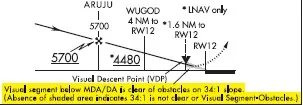
The profile view also gives us obstacle clues. Shading along the visual segment of the approach indicates the 34:1 slope is clear of obstacles. Absence of shading tells us there might be obstacles in our path.

But neither the plan nor profile views tell us whether obstacles are lit. That’s the job of “NA at Night” in the Notes Box.
Variations on the Theme
“Not authorized at night” notations can take various forms. Lonesome Pine has two. The Runway 6 instrument approach procedure is not authorized to be flown at night, period. The Runway 24 procedures are available, but only
for landing on Runway 24. No circling to 6 is permitted.
Here’s another variation. Sometimes VGSI, visual glideslope indicators such as PAPI and VASI, can be used instead of obstruction lighting to permit approach use. An example is in the Notes for the RNAV (GPS) 31 at KLEE in Leesburg, Florida.
A variation that generates discussion from time to time is found in the RNAV (GPS) RWY 26 approach into KCXU, Camilla-Mitchell County, Georgia. (See next page.) The Notes read, “Rwy 26 Straight-in and Circling minimums NA at night.” At first glance, it sounds like we can’t use the approach at all at night. But we can.

The key to this one is recalling something from our early instrument training. Remember those VOR-A approaches which are substantially straight to a runway but are circling because the final approach segment is offset more than 30 degrees or because the MDA requires a descent steeper than TERPS guidelines allow? Although the only minimums for the approach are circling minimums, we are permitted to land straight in using the circling minimums, so long as we may do so with normal maneuvering.
The Note on the KCXU approach chart is a more convoluted example but the underlying concept—the distinction between approach minimums and direction—is the same. The note is not telling us that landing straight in on Runway 26 and all circling is prohibited. Only that we are not authorized to use either straight in or circling minimums to land on Runway 26. We are permitted to circle to Runway 8.
Can I Use Runway 6 Anyway?
Let’s go back to Lonesome Pine and assume we think we can fly our preferred approach to Runway 6 without compromising safety. On this night our ceiling is 1500 feet. Surely, all we need to do is follow the procedure, descend through the clouds, break out, cancel IFR (assuming ATC can hear us), and land VFR. Plus, once we reach 700 feet AGL, we’re in Class G anyway. Do the rules allow us to do that? No.
On a job application, you might use “NA” to mean “Not Applicable.” On a calendar, it might mean “Not Available.” But when used for instrument procedures, it means “Not Authorized.” Moreover, unlike takeoff minimums and Obstacle Departure Procedures, which are optional for plain vanilla Part 91 operations like our Saratoga pilot with his family, “when it is necessary to use an instrument approach to a civil airport, each person operating an aircraft must use a standard instrument approach procedure prescribed in Part 97 of this chapter.” (§ 91.175(a)).
Using a procedure means following the rules of the procedure. So no, if the approach is not authorized, the approach is not authorized. Other than “because the FAA says so,” one reason might be that once we opt for the protections of instrument flight, we simply have to follow the rules that provide that protection.
Will ATC Clear Me Anyway?
There is no good answer to this question. It depends on who you ask.
May they clear us? Well yes, sort of. The current ATC manual, Order 7110.65Y, often referred to simply as the “Dot 65” tells controllers:
Approach clearances are issued based on known traffic. The receipt of an approach clearance does not relieve the pilot of his/her responsibility to comply with applicable Parts of Title 14 of the Code of Federal Regulations and the notations on instrument approach charts which levy on the pilot the responsibility to comply with or act on an instruction; for example, “Straight-in minima not authorized at night,” “Procedure not authorized when glideslope/glidepath not used,” “Use of procedure limited to aircraft authorized to use airport,” or “Procedure not authorized at night….” (Order 7110.65Y, Note 2 to ¶4-8-1.a.)
As a general proposition, unless it directly affects ATC—such as airspace incursions and deviations from clearances or instructions—ATC is not responsible for whether pilots comply with the rules. This paragraph tells controllers they may issue approach clearances based solely on traffic considerations. It is the pilot’s responsibility, not theirs, to comply with approach limitations and restrictions. Some controllers will wash their hands of any further responsibility and will clear you for the approach you want. Others will take a more proactive role and will not clear the pilot for an approach that is not authorized.
What Will You Do?
There are not many good options here other than diverting to another airport for the night or waiting until morning to leave. (Waiting until daylight is never a bad idea when contemplating a night flight into unfamiliar mountainous areas.) Even if ATC is willing to clear us for it—at our own risk of course—the IAP into Runway 6 is not authorized. If we did that, we’d get to add compliance risk to the physical risk of a mishap.
On the other hand, when we get our approach clearance, ATC usually doesn’t specify a straight-in landing or a circle to land from the MDA. So, in theory, we can be cleared for the Runway 24 approach and take it upon ourselves to circle to 6. We still have, however, the regulatory problem of circling to 6 not being authorized.
How about canceling IFR? This could take one of two forms. If the ceilings are high enough and Indianapolis Center’s MVA is low enough, they might be able to vector us far enough below the ceiling. Or, if radio communications can reach low enough, we can be cleared for an approach to Runway 24 and cancel when we reach visual conditions.
Canceling and flying a normal VFR traffic pattern into KLNP seems a reasonable alternative. At least there is a PAPI to offer us some visual protection on final. There are some cautions, however. The PAPI in this case was not considered sufficient to allow Runway 6 to be used for IFR operations at night. Ultimately, we are flying into an unfamiliar airport at night with unlit obstructions penetrating a normal approach path. Perhaps exercising yet more caution is in order.
Finally, we could, of course, accept the tailwind and land on 24. We have a full mile of runway available. If the density altitude is low enough and it is within our performance parameters, a GPS approach with an LPV glidepath, weather above the 300-foot straight-in minimums, and a high ceiling, this might well be a good option.

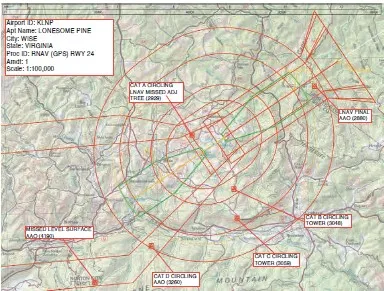
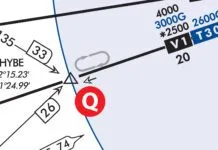
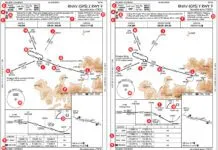
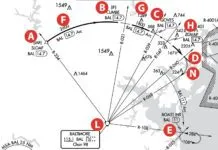
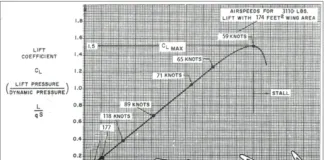
I do not understand this paragraph:
Here’s another variation. Sometimes VGSI, visual glideslope indicators such as PAPI and VASI, can be used instead of obstruction lighting to permit approach use. An example is in the Notes for the RNAV (GPS) 31 at KLEE in Leesburg, Florida.
Are you suggesting that the approach CAN be used at night? I would still consider straight in or circling to 31 to be NA at night under all circumstances.
Are you looking at the chart note in the article or the one on the current plate. This approach changed shortly after the article was written. Before the amendment, the note said, “when VGSI INOP, straight-in/circling rwy 31procedure NA night.” That’s the note referred to in the paragraph.
“All approaches have a visual segment.”
A Cat III ILS has a visual segment? Unless you count taxiing as part of the IAP, I do not believe it does. 🙂
I’m with Stephen. A GA pilot could not afford to keep his aircraft and himself current CAT III. There is no visual descent from a true CAT III approach only the big guys do that one!
Agree with You, Stephen and Kenneth. If we’re talking in CAT lll approachs, we can’t talk in their visual segments.
The “Can I use Runway 6 anyway?” paragraph should be revised. 91.175(a) is taken completely out of context. Keep in mind 91.175 is “landing under IFR” and if you are not under IFR, the section does not apply to you. I am NOT arguing that it is ‘safe’, but this approach is legal, and the article should be updated to reflect that.
I disagree, this approach is not legal to even start at night. You can’t even start the approach under IFR rules at night.
Precisely, Kenny.
The last sentence… “…this might well be a good option.” … The Author clearly has a different definition of the word “good” than I do.
In general I think circling to land is a bad idea in the daytime… much less at night… much less when the FAA says that it is a bad idea. I though that I read that the airlines always prohibit circle to land… which im sure that they do for a good reason.
This whole thing seems to really be more about what your estate lawyers will argue with the FAA about… and not what actually would be a good idea and be consistent with good ADM.
But that is just my opinion.
The author is not suggesting circle to land. He is talking about landing straight in to Rwy 24 with a tailwind.
“ The PAPI in this case was not considered sufficient to allow Runway 6 to be used for IFR operations at night.”
Why would a VGSI be insufficient for IFR yet still be sufficient for VFR? Is that because it is not coincident?
For added safety while night VFR, what about following the approach, but at the final approach segment, intercept the VGSI centerline instead to assure obstacle clearance? Are you saying that is a bad idea?